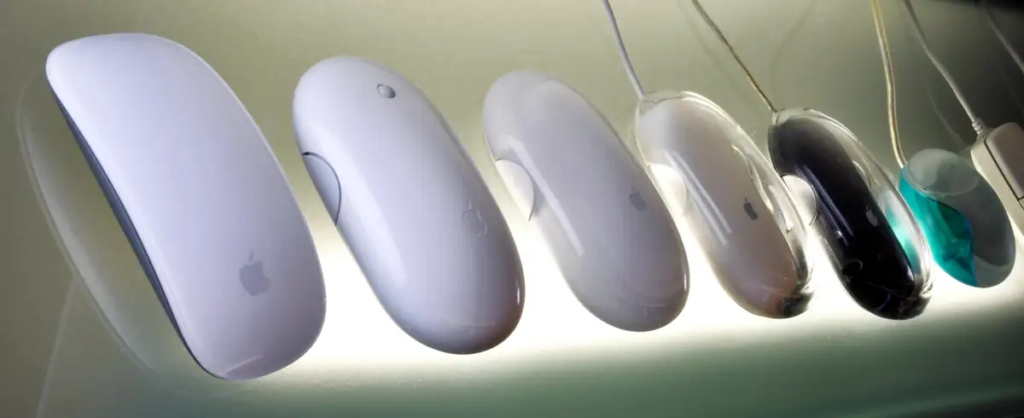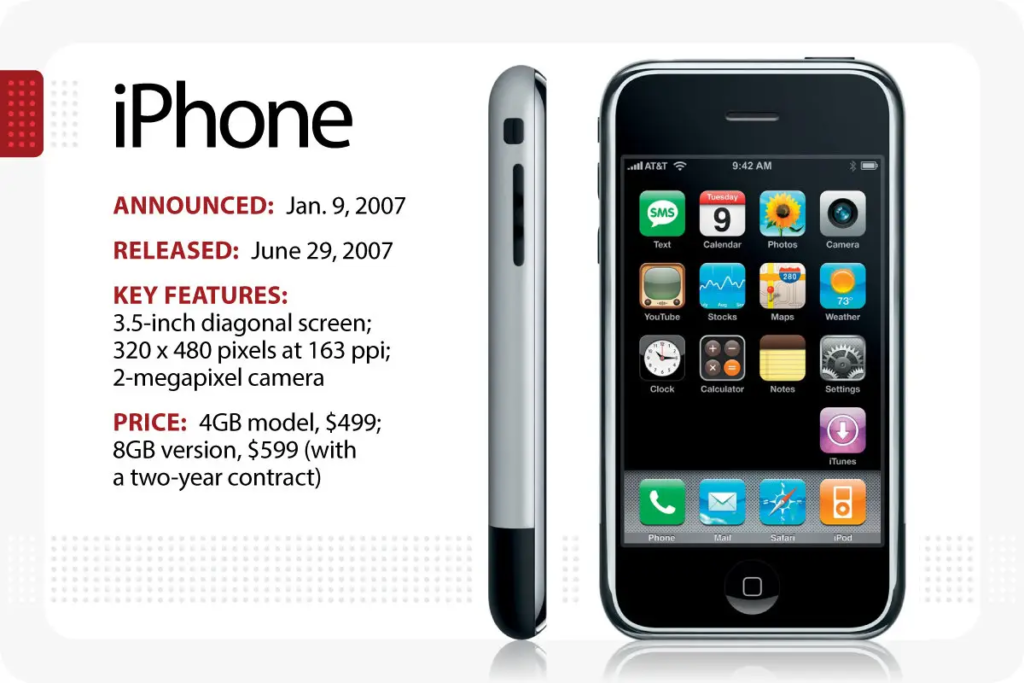
Table of Contents
- Introduction
- The 1970s: Inception of Apple Design
- The 1980s: The inherent focus on elevating Apple design
- 1998: The return of Jobs and the new iMac designs
- The 2000s: Design-led touch controls
- 2007: Unleashing the era of multi-touch user interface
- Key Takeaways
- Conclusion
Apple Inc today is the largest electronics consumer brand and the world’s most valuable company. It is the first to be valued at $3 trillion after crossing the $1 trillion mark in 2018. Apple’s innovative technology and unique design concept have been credited with this rapid growth. Fans, journalists, and technology geeks love to talk about Apple and the beautiful journey of Apple’s design history. Whether good or bad, we will be forever grateful to Apple’s ability to create products that stand out due to its consistency in design.
Be it the revolution created post the launch of the iPhone or the first iPod, Apple has always placed higher importance on design. Steve Jobs and Jony Ive, Chief Design Officer, are credited with developing this pioneering design language that defines everything Apple does today. Be it their unique products, the operating systems or apps that run on these devices, or the simplicity of how they communicate as an ecosystem. Apple’s focus on the more minor aspects of technology gives it a competitive advantage even today. As senior industrial designer Thomas Meyerhoffer puts it, “We wanted to put design-forward as a competitive tool for Apple, but nobody understood what design could do. There was a great urge from us in the design group to say: Apple is different; Apple has always been different.”

Keep reading if you wonder how Apple’s shift to becoming a design-centric technology company came about. This blog will explore Apple’s design history, the core principles behind its iconic design, and its evolution over the years. Let’s get started!

The 1970s: Inception Of Apple Design
The story of Apple’s design history is an interesting one. It is a known fact that Steve Jobs is a college dropout. During his Stanford Commencement speech in 2005, Jobs mentioned auditing a calligraphy class, something beyond his syllabus. His love for simplicity in design began and was also greatly enhanced by his pilgrimage to Rishikesh Ashram in India. His life was influenced profoundly by minimalism and Zen philosophy, which influenced him profoundly.

In the 1970s, when Jobs and his co-founders worked in this small family garage, his innate focus on design and technology began to take shape. Jobs would often frequent Sony’s sales office and keenly observe their marketing materials and product language. This was when Apple’s core design mantra took shape. As Jobs would describe it, “We will make them bright and pure and honest about being high-tech, rather than a heavy industrial look of black, black, black, black, like Sony. The way we’re running the company, the product design, the advertising, it all comes down to this: Let’s make it simple. Really simple.”
Simplicity in design thus became Apple’s core design value and became the foundation of Apple’s design history.
The 1980s: The Inherent Focus On Elevating Apple Design
His love for using design to depict Apple’s unique vision can be seen in the 1980s. As told by Apple employees, during the creation of the original Macintosh case in 1984, Jobs worked with two young designers, Jerry Manock and Terry Oyama, who drafted a preliminary design and had a plaster model made.
The comments from Steve Jobs were, “It’s way too boxy; it’s got to be more curvaceous. The radius of the first chamfer needs to be bigger, and I don’t like the size of the bevel.” Soon, iteration after iteration of similar criticism, Manock and Oyama finally created a sleek and narrow computer, in-line with Jobs’ insistence on making the machine look friendly. As Oyama tells it, “Even though Steve did not draw any of the lines, his ideas and inspiration made the design what it is.” This unique design was patented in Steve Jobs, Manock, and Oyama and defined Apple’s computers for the time to come.

1998: The Return Of Jobs And The New iMac Designs
Apple ousted Jobs from the company in 1985 for his obsession with design and aesthetics, which led to excess costs and delays. In this time, he worked on his following projects, NeXT and Pixar. However, life had a different plan for him, and in 1996, Apple would buy NeXT for $427 million, bringing Jobs back into Apple.
On his return, Steve Jobs found his ideal companion in Jonathan Ive, Apple’s Chief Design Officer. For both Ive and Jobs, design was not just about how a product looked on the surface but also reflected the product’s essence. And their first true success came with the iMac, which Jobs has defined as an all-in-one product, with keyboard and monitor and computer combined in one simple unit that was ready to use right out of the box.
Steve and Ive entirely redesigned the Mac monitor, and when it was unveiled, Jobs had a new comment, “I love the iMac, but we just delivered it in the wrong color.” Thus the iMac was born, available in a selection of five candy colors. This unique design and trendy colors were an instant hit in the market.

The 2000s: Design-Led Touch Controls
After the iMac, Jobs’s belief in simplicity led to the pinnacle design of Apple’s pioneering device, the iPod. Jobs immersed himself in the design of the iPod, and with each iteration, his requirement would be the same, ‘Simplify!’. After several tries, the iPod was finally ready. As Tony Fadell, the team leader, mentioned, “There would be times when we’d wrack our brains on a user interface problem, and think we’d considered every option, and he would go, ‘Did you think of this?'”
The iPod thus personified Job’s design principles and was much simpler than its rival MP3 players. With a beautiful screen, dial controls, and rich aesthetics, the iPod quickly became the market leader in its segment. With the combination of iTunes software and iPod hardware, Jobs quintessentially created a revolution in the music industry.

2007: Unleashing the Era of Multi-Touch User Interface
But Apple’s true revolution came with the iPhone, which took the simplicity of the iPod to a whole new level. As Andy Grignon, senior manager at Apple iPhone division, told, “Apple had just acquired a company called FingerWorks, which made multi-touch keyboards. So the idea was born to do a full touch-screen-based platform for the phone.”

Despite the mobile phone industry being completely new and dominated by many companies, Apple leaped to make a genuinely extraordinary phone. From the touch-screen display home button to the latest iOS operating system, Jobs concentrated on creating a device that was nothing like anything in the market. While the entire industry was focused on being smart, Apple was focused on being loved. And that focus helped it create its most successful product of all time, accounting for more than half its revenue.
Today, Apple devices still use the design philosophy set into motion by the visionary Steve Jobs. Whether it is the new iPad, refinements to the MacBook laptops, the iMacs that we know today, or even accessories like the iWatch or the Apple Earpods, each product infuses the design aesthetics rich-premium quality that makes Apple the #1 global electronics brand.
Key Takeaways
Pioneering. Simplistic. Beautiful.
These words define the vision of Apple design and are one of the primary reasons that help Apple create its next-generation innovation. Apple’s design philosophy and sensibility can be summarised in the following points:
- Focus on simplicity: Apple’s design was simple and easy to use, more than eye-catching or flashy. This sophisticated design principle has ensured that despite its clean and simple design approach, its designs are good-looking and appeal to a wide range of audiences.
- Customer-centric: Steve Jobs believes in putting himself in the customer’s shoes, and this is a practice among engineers and designers when creating products for Apple customers. Be it its products or systems, Apple has consistently focused on ensuring that its design is clutter-free, clean, and elegant. From the minimalist design for the iPhone and iPads or the simple design of the iMac and MacBook, each device focuses on providing features and interfaces that make it easy to use for various users.
- Attention to detail: Apple has always believed in refining and redefining its products, enabling each new iteration to be much better than its previous generation. A simple example is the MacBook’s internal fan speed, which is programmed to slow down when voice dictation is enabled. This has been done so that the machine clearly understands the user’s voice and proves how minute attention is given to every aspect of the product.
- Quality, above all: Apple products are always known for their premium pricing. Despite competition from new players, Apple always has focused on its quality. It is also seen in its design language, as Apple branding, its logo, and the overall focus on providing exceptional quality. Apple products instill a pride of ownership and are instantly recognizable due to their distinct design and quality.
Conclusion
Apple’s pioneering design has set into motion a revolution in the industry, as more brands are today focusing on simplicity and user-centric design to set their brand apart. Many companies have tried to mimic Apple’s design principles. Still, Apple stands out despite increasing competition mainly thanks to its unique focus on using design as a functionality rather than as an aesthetic. The book ‘Designed by Apple in California’ is a great starting point for a more in-depth understanding of Apple’s design history. In Steve Jobs’ book, Apple’s design philosophy and methods were documented in tribute to his memory. The book illustrates Apple’s design principles using custom-dyed paper and silver edges with low-ghost ink. You can get more details of the book here: Designed by Apple in California Book Release.
Looking for content writing services for your brand? Pepper Content is a great platform for everything from website content writing services to product content.
FAQs
The key aspect of Apple’s design style is its focus on minimalism and simplicity. All Apple products are designed with simplicity in mind and have a clean, neat, and sophisticated look, which has helped set its products apart from the competition. It uses clean and simple graphics clear fonts, and the overall product design and easy-to-use and straightforward.
While the core to Apple’s design is the visionary Steve Jobs, Jobs’ partnerships with Hartmut Esslinger in the 1980s and then with Jony Ive starting in 1997 created an engineering and design aesthetic that set Apple apart from other technology companies.
Steve Jobs was always impressed by the industrial design style of companies that he would see when Apple was still a company that operated out of Jobs’ family garage. During this time, he studied Sony’s distinctive design style and often studied their marketing materials and brochures to look for unique design features. During the 1981 annual International Design Conference in Aspen, Colorado, Jobs was taken in by multiple artists’ clean and functional approaches, which Jobs incorporated into Apple’s designing of products.
Steve Jobs places simplicity as the vital aspect for all Apple’s products. He believed that making a product easy-to-use would make users more satisfied with their purchase because they could then use the product without reservation on almost any occasion.
Apple has key guiding principles that define all the products and applications that the company builds. The key is that the product or application should be easy to use and straightforward, with a design aesthetic enhancing its functionality, not just its appearance. This focus on simplicity and high standards of design enforced across Apple products help it stand out from its competition and define the Apple legacy.
Steve Jobs was obsessed with creating the ‘best’ of everything and even focused on getting rid of minor flaws before bringing the product to market. This obsession with the simplicity and user-friendliness of the products defines the design principles of Apple and has helped it become a market leader in its segment.
Latest Blogs
Explore how Google’s 2025 AI search updates triggered ranking chaos. Learn actionable strategies to adapt your SEO for AI Overviews, zero-click searches, and SERP volatility. Stay ahead now.
Learn how to rank on AI search engines like ChatGPT, Perplexity, and Gemini by optimizing your content for authority, structure, and relevance. Stay ahead in AI-driven search with this strategic guide.
Explore the best healthcare SEO services for your medical practice. Improve online visibility and effectively reach more patients in need of your services.
Get your hands on the latest news!
Similar Posts

Design
7 mins read
15 Best Firms Offering Design Services in India

Design
5 mins read
All You Need to Know About Data-Driven Design

Design
6 mins read